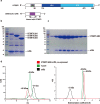Crystal structure of SARS-CoV-2 Orf9b in complex with human TOM70 suggests unusual virus-host interactions
- PMID: 33990585
- PMCID: PMC8121815
- DOI: 10.1038/s41467-021-23118-8
Crystal structure of SARS-CoV-2 Orf9b in complex with human TOM70 suggests unusual virus-host interactions
Abstract
Although the accessory proteins are considered non-essential for coronavirus replication, accumulating evidences demonstrate they are critical to virus-host interaction and pathogenesis. Orf9b is a unique accessory protein of SARS-CoV-2 and SARS-CoV. It is implicated in immune evasion by targeting mitochondria, where it associates with the versatile adapter TOM70. Here, we determined the crystal structure of SARS-CoV-2 orf9b in complex with the cytosolic segment of human TOM70 to 2.2 Å. A central portion of orf9b occupies the deep pocket in the TOM70 C-terminal domain (CTD) and adopts a helical conformation strikingly different from the β-sheet-rich structure of the orf9b homodimer. Interactions between orf9b and TOM70 CTD are primarily hydrophobic and distinct from the electrostatic interaction between the heat shock protein 90 (Hsp90) EEVD motif and the TOM70 N-terminal domain (NTD). Using isothermal titration calorimetry (ITC), we demonstrated that the orf9b dimer does not bind TOM70, but a synthetic peptide harboring a segment of orf9b (denoted C-peptide) binds TOM70 with nanomolar KD. While the interaction between C-peptide and TOM70 CTD is an endothermic process, the interaction between Hsp90 EEVD and TOM70 NTD is exothermic, which underscores the distinct binding mechanisms at NTD and CTD pockets. Strikingly, the binding affinity of Hsp90 EEVD motif to TOM70 NTD is reduced by ~29-fold when orf9b occupies the pocket of TOM70 CTD, supporting the hypothesis that orf9b allosterically inhibits the Hsp90/TOM70 interaction. Our findings shed light on the mechanism underlying SARS-CoV-2 orf9b mediated suppression of interferon responses.
Conflict of interest statement
The patent protecting the design and application of the C-peptide (including its derivatives) originated from SARS-CoV-2 orf9b sequence is pending by the authors of this paper and the Institute of Pathogen Biology, Chinese Academy of Medical Sciences and Peking Union Medical College, China. The authors declare no other competing interests.
Figures




Similar articles
-
Phosphorylation of SARS-CoV-2 Orf9b Regulates Its Targeting to Two Binding Sites in TOM70 and Recruitment of Hsp90.Int J Mol Sci. 2021 Aug 26;22(17):9233. doi: 10.3390/ijms22179233. Int J Mol Sci. 2021. PMID: 34502139 Free PMC article.
-
Binding of SARS-CoV-2 protein ORF9b to mitochondrial translocase TOM70 prevents its interaction with chaperone HSP90.Biochimie. 2022 Sep;200:99-106. doi: 10.1016/j.biochi.2022.05.016. Epub 2022 May 26. Biochimie. 2022. PMID: 35643212 Free PMC article.
-
The Orf9b protein of SARS-CoV-2 modulates mitochondrial protein biogenesis.J Cell Biol. 2023 Oct 2;222(10):e202303002. doi: 10.1083/jcb.202303002. Epub 2023 Sep 8. J Cell Biol. 2023. PMID: 37682539 Free PMC article.
-
The Mitochondrial Outer Membrane Protein Tom70-Mediator in Protein Traffic, Membrane Contact Sites and Innate Immunity.Int J Mol Sci. 2020 Oct 1;21(19):7262. doi: 10.3390/ijms21197262. Int J Mol Sci. 2020. PMID: 33019591 Free PMC article. Review.
-
SARS-CoV-2, the pandemic coronavirus: Molecular and structural insights.J Basic Microbiol. 2021 Mar;61(3):180-202. doi: 10.1002/jobm.202000537. Epub 2021 Jan 18. J Basic Microbiol. 2021. PMID: 33460172 Free PMC article. Review.
Cited by
-
Structural characterization of SARS-CoV-2 dimeric ORF9b reveals potential fold-switching trigger mechanism.Sci China Life Sci. 2023 Jan;66(1):152-164. doi: 10.1007/s11427-022-2168-8. Epub 2022 Sep 29. Sci China Life Sci. 2023. PMID: 36184694 Free PMC article.
-
Mechanisms of Antiviral Immune Evasion of SARS-CoV-2.J Mol Biol. 2022 Mar 30;434(6):167265. doi: 10.1016/j.jmb.2021.167265. Epub 2021 Sep 22. J Mol Biol. 2022. PMID: 34562466 Free PMC article. Review.
-
FAM210B activates STAT1/IRF9/IFIT3 axis by upregulating IFN-α/β expression to impede the progression of lung adenocarcinoma.Cell Death Dis. 2025 Feb 3;16(1):63. doi: 10.1038/s41419-025-07375-9. Cell Death Dis. 2025. PMID: 39900908 Free PMC article.
-
A Cullin 5-based complex serves as an essential modulator of ORF9b stability in SARS-CoV-2 replication.Signal Transduct Target Ther. 2024 Jun 28;9(1):159. doi: 10.1038/s41392-024-01874-5. Signal Transduct Target Ther. 2024. PMID: 38937432 Free PMC article.
-
An allosteric network governs Tom70 conformational dynamics to coordinate mitochondrial protein import.bioRxiv [Preprint]. 2025 Jul 23:2025.07.19.665690. doi: 10.1101/2025.07.19.665690. bioRxiv. 2025. PMID: 40777325 Free PMC article. Preprint.
References
-
- WHO Coronavirus Disease (COVID-19) Dashboard. https://covid19.who.int/ (2020).
Publication types
MeSH terms
Substances
LinkOut - more resources
Full Text Sources
Other Literature Sources
Molecular Biology Databases
Miscellaneous

